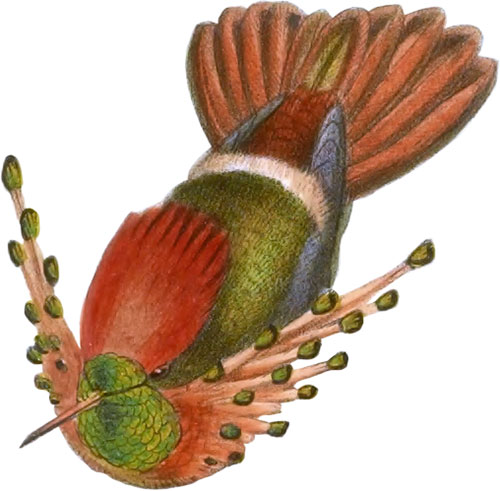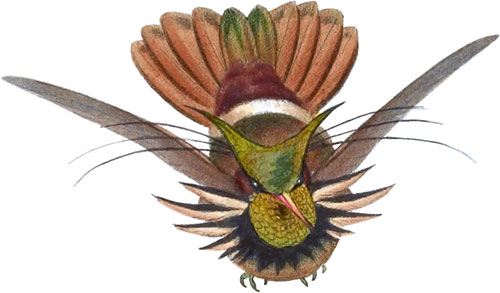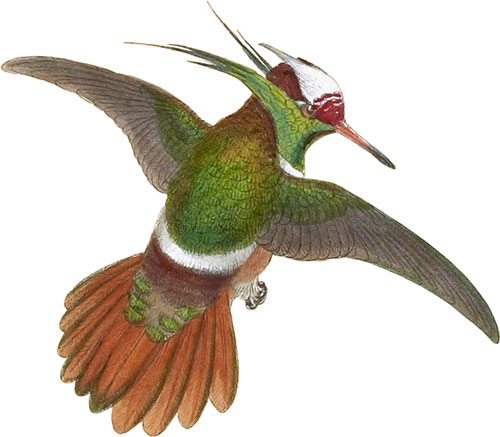The present species was discovered by Mr. Henry Whitely during his well-known exploration of British Guiana, where he met with it on the Merumé Mountains and on Roraima at a height of from 3000 to 3500 feet.
Messrs. Salvin and Godman state that it is allied to L. verreauxi, but differs in many particulars; the head, instead of having the forehead green and the occiput black, has a black central streak running from the base of the bill to the nape, on each side of which is a broad green streak. The elongated green feathers on each side of the neck are broad, and have a conspicuous black spot near the apex of each feather, this spot in the largest feathers being quite large. The feathers of the front extend much further along the culmen of the bill than in L. verreauxi, and in this respect recall this peculiarity in the genus Orthorhynchus.
Mr. Whitely’s first collection contained only a single example of this Humming-bird, which he obtained at a height of 2000 feet. He has kindly sent us the following account of its capture:—
After ascending the Merumé Mountains from the Merumé river-side, I met with a terrible gunpowder accident which deprived me of the use of my hands for over a month, and the Indians brought me to a hut amongst the hills, travelling about 17 miles in a northerly direction from the top of the Chichi falls on the Upper Mazarune. The hut was situated on the open savannah, with a large forest at the back, and here on my restoration to health my first collection from the mountainous country of British Guiana was made. At this season of the year (June and July 1881) there were many large trees in the forest bearing large bunches of white flowers, and these were frequented by numerous species of Humming-birds; but from the great height of the trees I was forced to get my Indians to climb halfway up, and then stand on some of the overhanging branches to shoot them, so that it was not possible to observe much of their habits.
This interesting bird was the only one obtained, and though we were constantly on the watch for more, we never got a second example, and I should fancy that it was a bird that had strayed out of its usual haunts, attracted by the flowers. The stomach contained remains of very minute insects.
Two males and a female are figured on the Plate, drawn from a pair of specimens lent to us by Messrs. Salvin and Godman.
[R. B. S.]
 Lophornis ornatus
Tufted Coquette
Lophornis ornatus
Tufted Coquette
 Lophornis Gouldi
Gould’s Coquette
Lophornis Gouldi
Gould’s Coquette
 Lophornis magnificus
Frilled Coquette
Lophornis magnificus
Frilled Coquette
 Lophornis Regulus
Great-Crested Coquette
Lophornis Regulus
Great-Crested Coquette
 Lophornis Delattrei
DeLattre’s Coquette
Lophornis Delattrei
DeLattre’s Coquette
 Lophornis Reginæ
Spangled Coquette
Lophornis Reginæ
Spangled Coquette
 Lophornis Helenæ
Princess Helena’s Coquette
Lophornis Helenæ
Princess Helena’s Coquette
 Lophornis adorabilis
Salvin’s Coquette
Lophornis adorabilis
Salvin’s Coquette
Featuring all 422 illustrated species from John Gould’s A Monograph of the Trochilidæ, or Family of Humming-Birds arranged by color.